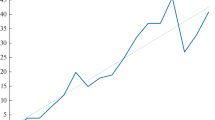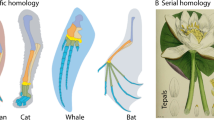Abstract
The homology concept has had a long and varied history, starting out as a geometrical term in ancient Greece. Here we describe briefly how a typological use of homology to designate organs and body parts in the same position anatomically in different organisms was changed by Darwin’s theory of evolution into a phylogenetic concept. We try to indicate the diversity of opinions on how to define and test for homology that has prevailed historically, before the important books by Hennig (1950. Grundzüge einer Theorie der Phylogenetischen Systematik. Deutscher Zentralverlag, Berlin) and Remane (1952. Die Grundlagen des Natürlichen Systems, der Vergleichenden Anatomie und der Phylogenetik. Geest & Portig, Leipzig) brought more rigor into both the debate on homology and into the usage of the term homology among systematists. Homology as a theme has recurred repeatedly throughout the history of the “Phylogenetisches Symposium” and we give a very brief overview of the different aspects of homology that have been discussed at specific symposia over the last 48 years. We also honour the fact that the 2004 symposium was held in Jena by pointing to the roles played by biologists active in Jena, such as Ernst Haeckel and Carl Gegenbaur, in starting the development towards a homology concept concordant with an evolutionary world view. As historians of biology, we emphasize the importance of major treatises on homology and its history that may be little read by systematists active today, and have sometimes also received less attention by historians of biology than they deserve. Prominent among these are the works of Dietrich Starck, who also happened to be both a student, and later a benefactor, of systematics at Jena University.
Similar content being viewed by others
Explore related subjects
Discover the latest articles and news from researchers in related subjects, suggested using machine learning.References
Abouheif, E., 1997. Developmental genetics and homology: a hierarchical approach. Trends Ecol. Evol. 12, 405–408.
Bljacher, L.Ja, 1965. Analogie und Homologie. Studien zur Geschichte der Morphologie, Part 6. In: Der Entwicklungsgedanke in der Biologie, Moskau, pp. 123–130 (in Russian).
Camper, P., 1784. Kurze Nachricht von der Zergliederung verschiedener Orang-Utans. Herrn Pieter Campers kleine Schriften. Part 2, vol. 1. Verlag S. L. Crusins, Leipzig, pp. 65–94.
Camper, P., 1785. Nachricht vom Sprachwerkzeuge des Orang-Utan. Herrn Pieter Campers sämtliche kleinere Schriften. Verlag S. L. Crusins, Leipzig.
de Beer, G., 1971. An Unsolved Problem. Oxford University Press, Oxford.
Dickinson, W.J., 1995. Molecules and morphology: where’s the homology? Trends Genet. 11, 119–121.
Freye, H.A., 1967. Kompendium der Zoologie, third ed. Gustav Fischer, Jena.
Friedrich, H., 1932. Kritische Studien zur Geschichte und zum Wesen des Begriffes der Homologie. Ergebn. Anat. 29, 25–86.
Gegenbaur, C., 1878. Grundzüge der vergleichenden Anatomie, second ed. Wilhelm Engelmann, Leipzig.
Geoffroy, St. Hilaire, E., 1825. Mémoires sur la structure et les usages de l’appareil olfactif. Ann. Des Sci. Natur. 6.
Gersch, M., 1964. Vergleichende Endokrinologie der wirbellosen Tiere. Akademische Verlagsgesellschaft, Leipzig.
Gersch, M., 1967. Neuere Ergebnisse über Neurohormone der Insekten. Forsch. Fortsch. 41, 257–261.
Gould, S.J., 1977. Ontogeny and phylogeny. Harvard University Press, Cambridge, Massachusetts.
Haeckel, E., 1866. Generelle Morphologie der Organismen, vol. 2. Georg Reimer, Berlin.
Haeckel, E., 1872. Monographie der Kalkschwämme, vol. 3. Georg Reimer Verlag, Berlin.
Hall, B.K. (Ed.), 1994. Homology. The Hierarchical Basis of Comparative Biology. Academic Press, San Diego.
Hennig, W., 1950. Grundzüge einer Theorie der Phylogenetischen Systematik. Deutscher Zentralverlag, Berlin.
Hermann, T., Kleisner, K., 2005. The Five “Homes” of zoologist Mikhail M. Novikov (1876–1965). Analogy and adaptation in one’s life and as a principle of biological investigation. Jahrb. Europ. Wissenschaft. 1, 87–130.
Hoßfeld, U., 2002. ‘Konstruktion durch Umkonstruktion’—Hans Bökers vergleichende biologische Anatomie der Wirbeltiere. Verh. Gesch. Theor. Bio. 9, 149–169.
Hoßfeld, U., Olsson, L., 2003a. The road from Haeckel. The Jena tradition in evolutionary morphology and the origin of “Evo-Devo”. Biol. Philos. 18, 285–307.
Hoßfeld, U., Olsson, L., 2003b. The History of Comparative Anatomy in Jena—An Overview. Theory Biosci. 122, 109–126.
Hoßfeld, U., Olsson, L., Breidbach, O. (Eds.), 2003. Carl Gegenbaur and Evolutionary Morphology. Theory Biosci. 122 (2/3).
Junker, T., Hoßfeld, U., 2001. Die Entdeckung der Evolution. Eine revolutionäre Theorie und ihre Geschichte. WBG, Darmstadt.
Kraus, O., 1984. Die Veranstaltung „Phylogenetisches Symposium”: Rückblick auf 25 Tagungen (1955–1982), Verh. des naturwiss. Ver. Hamb. (NF) 27, 277–289.
Kraus, O., Hoßfeld, U., 1998. 40 Jahre „Phylogenetisches Symposion” (1957–1997): eine Übersicht. Anfänge, Entwicklung, Dokumentation und Wirkung. Jahrb. Gesch. Theor. Biol. 5, 157–186.
Lankester, E. R., 1870. On the use of the term homology. Ann. Magaz. Nat. Hist. Zool. Bot. Geol. 6, 34–43.
Laubichler, M.D., 2000. Homology in development and the development of the homology concept. Am. Zool. 40, 777–788.
Levit, G., Hoßfeld, U., Olsson, L., 2004. The integration of darwinism and evolutionary morphology: Alexej Nikolajevich Sewertzoff (1866–1936) and the developmental basis of evolutionary change. J. Exp. Zool. B. (Mol. Dev. Evol.) 302, 343–354.
Meissner, K., 1976. Homologieforschung in der Ethologie. VEB Gustav Fischer, Jena.
Meissner, K., 1978. Homologiekriterien als Mittel des Erkenntnisgewinns. In: Tembrock, G., Geissler, E. Scheler, W. (Eds.), Philosophische und Ethische Probleme der Modernen Verhaltensforschung. Akademie-Verlag, Berlin, pp. 179–206.
Meister, K., 2005. Metaphysische Konsequenz. Die idealistische Morphologie Edgar Dacques. Neues Jb. f. Geol. Paläontol. Abh. 235, 197–233.
Mitgutsch, C., 2003. On Carl Gegenbaur’s theory on head metamerism and the selection of taxa for comparisons. Theory Biosci. 122, 204–229.
Müller, G.B., Wagner, G.P., 1996. Homology, Hox genes, and developmental integration. Am. Zool. 36, 4–13.
Naef, A., 1926. Zur Diskussion des Homologiebegriffes und seiner Anwendung in der Morphologie. Biol. Zentralbl. 46, 405–427.
Naef, A., 1927. Die Definition des Homologiebegriffes. Biol. Zentralbl. 47, 187–190.
Nowikoff, M., 1935. Homomorphie, Homologie und Analogie. Anatom. Anz. 80, 388–392.
Owen, R., 1848. On the Archetype and Homologies of the Vertebrate Skeleton. John Van Voorst, London.
Panchen, A.L., 1999. Homology-history of a concept. In: Bock, G.R., Cardew, G. (Eds.), Homology. Novartis Foundation Symposium 222. Wiley, Chichester, pp. 5–17.
Plate, L., 1922. Allgemeine Zoologie und Abstammungslehre. Gustav Fischer, Jena.
Raff, R.A., 1996. The Shape of Life. Genes, Development, and the Evolution of Animal Form. University of Chicago Press, Chicago.
Remane, A., 1952. Die Grundlagen des Natürlichen Systems, der Vergleichenden Anatomie und der Phylogenetik. Geest & Portig, Leipzig.
Remane, A., 1955. Morphologie als Homologienforschung. Ver. Dtsch. Zool. Ges. 1954 in Tübingen, 159–183.
Remane, A., 1960. Das soziale Leben der Tiere. Rowohlt, Hamburg.
Remane, J., 1989. The development of the homology-concept since Adolf Remane. Zool. Beitr. N.F. 32 (3), 497–503.
Rieppel, O., 1994. Homology, topology, and typology: The history of modern debates. In: Hall, B.K. (Ed.), Homology. The Hierarchical Basis of Comparative Biology. Academic Press, San Diego, pp. 63–100.
Roth, V.L., 1988. The biological basis of homology. In: Humphries, C.J. (Ed.), Ontogeny and Systematics. Columbia University Press, New York, pp. 1–26.
Rupke, N.A., 1994. Richard Owen, Victorian Naturalist. Yale University Press, New Haven.
Schmitt, St., 2004. Histoire d’une question anatomique. La répétition des parties. Publications Scientifiques du Muséum National d’Histoire Naturelle (Archives, 6), Paris.
Spemann, H., 1915. Zur Geschichteu und Kritik des Begriffs der Homologie. In: Chun, C., Johannsen, W. (Eds.), Allgemeine Biologie. B. G. Teubner, Leipzig/Berlin, pp. 63–85.
Starck, D., 1950. Wandlungen des Homologiebegriffes. Zool. Anz. 145, 957–969.
Starck, D., 1963. Die Metamerie des Kopfes der Wirbeltiere. Zool. Anz. 170, 393–428.
Tembrock, G., 1967. Grundlagen der Tierpsychologie. Akademie-Verlag, Berlin.
Tembrock, G., 1989. Homologisieren in der Ethologie. Zool. Beitr. N.F. 32 (3), 425–436.
Voigt, W., 1973. Homologie und Typus in der Biologie. Weltanschaulich-philosophische und erkenntnistheoretisch-methodologische Probleme. Gustav Fischer, Jena.
Wake, D.B., 2003. Homology and homoplasy. In: Hall, B.K., Olson, W.M. (Eds.), Keywords & Concepts in Evolutionary Developmental Biology. Harvard University Press/MA, London/England.
Wagner, G.P., 1995. The biological role of homologues: A building block hypothesis. N. Jb. Geol. Palaont. Abh. 195, 279–288.
Wickler, W., 1965. Über den taxonomischen Wert homologer Verhaltensmerkmale. Die Natur. 52, 441–444.
Wickler, W., 1967. Vergleichende Verhaltensforschung und Phylogenetik. in: Heberer, G. (Ed.), Die Evolution der Organismen, third ed. vol. I. Gustav Fischer, Stuttgart/Jena, pp. 420–508.
Author information
Authors and Affiliations
Corresponding author
Rights and permissions
About this article
Cite this article
Hoßfeld, U., Olsson, L. The history of the homology concept and the “Phylogenetisches Symposium”. Theory Biosci. 124, 243–253 (2005). https://doi.org/10.1007/BF02814486
Received:
Accepted:
Issue Date:
DOI: https://doi.org/10.1007/BF02814486




